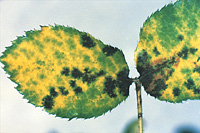While plant pathologists work very hard to prevent plant diseases, occasionally their work attracts national attention or a disease becomes so important that the disease itself becomes news.
-
National Public Radio has aired several programs on plant diseases in recent years. . .
-
On June 6, 2001, a four-minute segment was aired which explained how scientists at North Carolina State University had used new DNA technologies to track the origin of potato late blight, an important disease that caused so much misery in Ireland in the 1840's and which is still a problem in the US today.
-
On January 1, 2000, a four-minute segment was aired on the outbreak of citrus canker in Florida. Citrus canker is a bacterial disease, and it is posing a serious threat to Florida's citrus crop. The segment reported that state officials are burning hundreds of acres of the lime groves in southern Florida hoping to stop this disease from spreading even farther in Florida and to other parts of the U.S.
-
On February 19, 1997 NPR's Richard Harris reported in a four-minute segment that scientists were investigating how plants communicate with one another. The research suggested that chemicals emitted by virus-infected plants wafted into the air to healthy plants and helped them to fight infection.
These audio reports can be retrieved from the Archives of National Public Radio by going to www.npr.org and searching by subject in the archive search engine in the "All Things Considered" program section. These and additional audio reports are listed in this website in the "Resource Guide to Materials Related to Plant Path-Ways to Science." Resources are organized into sections including a website list which includes a sub-section called "Plant Pathology on the Airwaves."
Additional information and images on potato late blight (August, 2001) and citrus canker (January, 2001) are featured in the archives of the K-12 "News and Views."
 |
Views: Black spot of rose is a very important disease that is caused by a fungus called Diplocarpon rosae. The symptoms of this disease are highly diagnostic. Under certain conditions, the disease can cause a very unsightly appearance of the entire plant and even complete defoliation. Click image for an enlarged view and more information. |
